There’s not much gold left in the area, but the big dreams that drove early Californian settlement survive today in the humble mountain town of Mariposa.
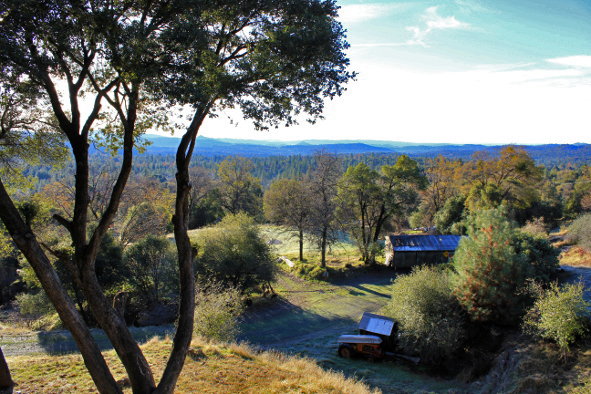
A view from just outside Mariposa (photo credit: Jeff Rindskopf)
I stoop over the tiny stream to dip one edge of my pan in the running water, just long enough to collect a handful of dull sediment, and then swirl it all around so the lighter grains spill back into the stream. The hope is to find a few chunks of gold among the sediment, but I don’t see a speck of it in the entire hour I spend perched on this slippery patch of rock. It turns out panning for gold requires a lot of patience, and a lot of physical endurance.
The stream is on the edge of a town called Mariposa, a tiny gold country hamlet most visitors only stop in long enough for a night’s sleep on their way to nearby Yosemite National Park. Admittedly, I wouldn’t stay any longer if I didn’t have family living in town.
But it’s lucky I do. Though it’s come a long way from its heyday as a mountainside center of gold rush commerce, Mariposa is an immediately homey small town with close ties to California’s history and culture—a culture built on big, often unrealistic dreams. It’s a miniature cultural gem in the midst of a gorgeous Sierra Nevada landscape, not unlike a chunk of gold waiting to be found beneath a creek of crystal clear mountain runoff.
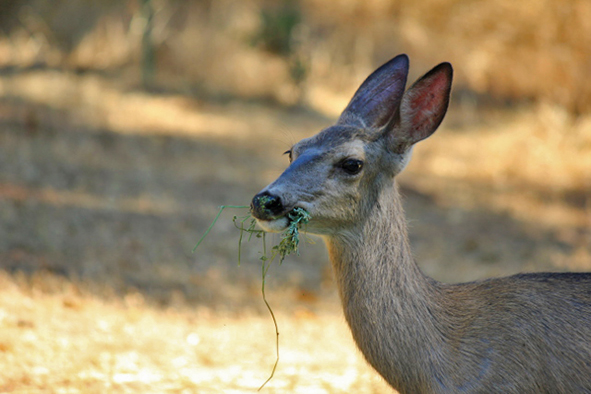
A deer enjoying a meal in Mariposa (photo credit: Jeff Rindskopf)
A Background of Mariposa
Most of my knowledge of Mariposa’s lengthy history—lengthy by California standards, at least—comes from the Mariposa Museum & History Center, which is filled with antiques reconstructed into full rooms like life-sized dioramas of how life used to be. Mariposa County was created at the time of California’s statehood in 1850, while hopeful settlers were still rushing in from the east to find gold in a territory that only recently belonged to Mexico.
The Mariposa mine provided a steady source of employment and turned the town into a supply hub. Mariposa became the county seat as well in 1854, when they built the Mariposa County Courthouse. The handsome, wood-paneled building still stands in the middle of town today and is now the longest-continually operating courthouse west of the Rockies. It’s staffed on weekends but otherwise deserted, so visitors can explore the rooms, and even sit behind the judge’s bench and preside over an empty courtroom.
Stately as it is, the courthouse couldn’t compare to the childish wonder I felt skulking around the nearby old stone jailhouse, now closed. There isn’t much to see around the intimidating building of granite slabs, but it’s enough to make me imagine all the Old West shenanigans that must have ended there.
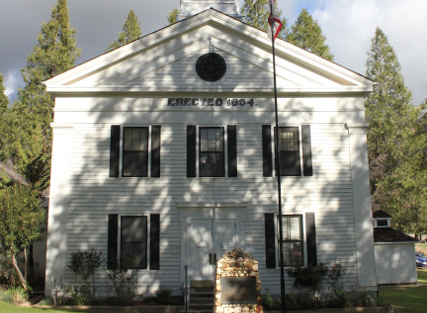
The Mariposa County Courthouse (photo credit: Jeff Rindskopf)
I drive to a museum on the edge of town, just past an empty fairground of tall grass that’s turned amber with the autumn weather, just like everything else. In the Mining Museum, I gawk at glass cases of vibrant rocks and gems formed naturally into fantastic geometric shapes. The museum worker leads our tiny tour group through an underground portion of the museum, where painted mannequins demonstrate the old mining processes used in the region.
He regales us with tales of their wildly unsafe profession before moving onto a room filled with early photos of the mining settlements that popped up throughout the region in the 19th century. His passion for the niche subject matter is infectious and makes my museum trip.
When I ask about the early days of California’s mining settlement, the museum worker says that San Francisco became an urban center during the gold rush because all the rivers in the region led there. The merchants followed the river and fled to a growing new city, but others stayed in these rugged foothills, chasing the impossible, back-breaking dream of striking gold and building towns like Mariposa along their way.
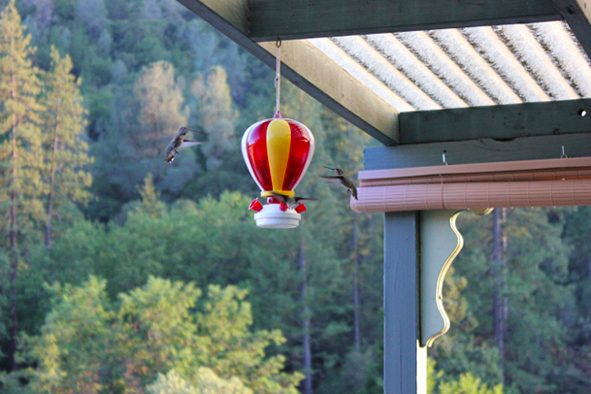
A busy hummingbird feeder in Mariposa (photo credit: Jeff Rindskopf)
An Enduring Legacy
A little later, I find the names of many of those early settlers carved in stone at the Mariposa Town Cemetery, filled with both elaborate headstones listing accomplishments and more modest slabs of stone that give only names and dates. It has a gloomy beauty that seems perfectly fitting for a cemetery, and I spend a morose half-hour admiring the most striking graves and engravings.
There’s a nice simple view from here—just a few blocks of old buildings and then steep hills of endless oak treetops that just seem to keep rising until they turn into distant white-capped peaks. I remember Mariposa’s city motto, “below the snow, above the clouds.” I look west, and sure enough, I can see some of the morning fog melting off the hills below us. In the opposite direction, there’s a spot where the trees crowding the two lane highway turn suddenly from twisty oaks to stout evergreens as the tiny road winds its way around a cliff and up the mountain.
Before leaving, I stop at a small park outside the History Center decorated by historic structures and old pieces of mining equipment that function as free outdoor displays. One piece of equipment is an enormous rusty stamp mill that was once used to extract and crush gold ore, an industrial fixture of the hard rock mining that dominates the industry today. Apparently, most of the “placer gold”—minerals found loose in creek-beds and sediment deposits—has already been found, not that there was that much in the first place.
Fortunately, that didn’t stop settlers like those buried in the cemetery from using their dreams of discovering gold as cause to create a thriving frontier town with a powerful sense of community every small town should have. Tourism may have supplanted mining as the region’s chief industry, but I like to think the foolhardy hope that characterized Mariposa’s early history survives today, if only in the form of uninformed tourists like me. My panning for gold may have been a pipe dream, but then again, I suppose it always was.
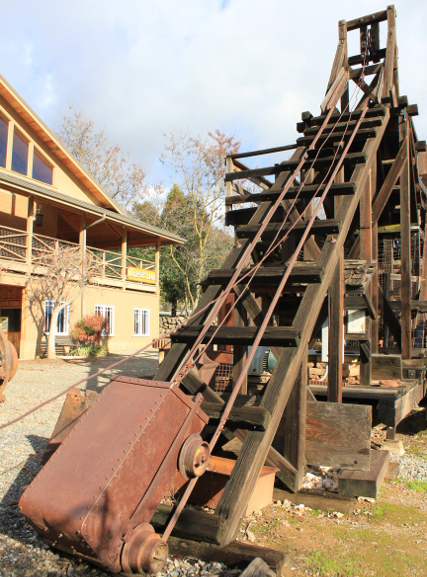
The stamp mill outside the Mariposa Museum & History Center (photo credit: Jeff Rindskopf)